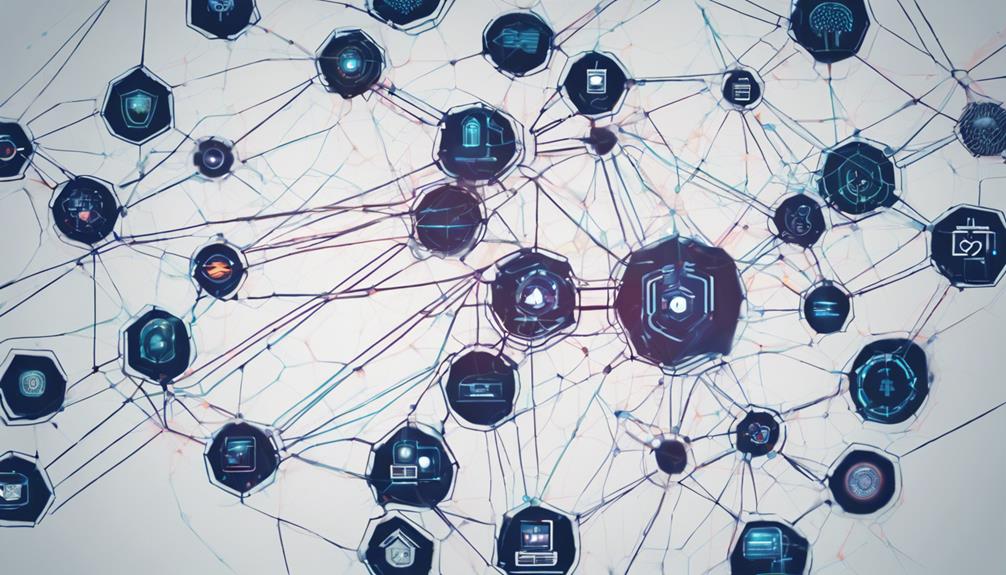Harness AI in cybersecurity for precise threat detection and proactive security. Utilize machine learning for real-time monitoring, empowering swift threat responses and predictive analytics. Integrate adaptive AI systems to dynamically counter emerging threats. Guarantee ethical AI deployment through oversight and diverse datasets to combat biases. Benefit from enhanced threat detection, swift data analysis, and automated incident response. Be aware of risks like biases, data quality, and privacy concerns. Explore tools like Darktrace and Cylance for exceptional security. Follow best practices with regular updates, staff training, and data quality measures. Embrace AI's future for advanced threat detection and proactive defense.
Key Takeaways
- Implement real-time monitoring with AI for swift threat detection.
- Utilize AI for proactive anomaly detection and immediate incident responses.
- Integrate adaptive AI systems to evolve defense mechanisms dynamically.
- Ensure ethical AI deployment with oversight, diverse datasets, and ongoing audits.
- Benefit from AI in cybersecurity for enhanced threat detection and automated incident response.
Understanding AI Capabilities in Cybersecurity
AI plays a vital role in cybersecurity by leveraging advanced technologies to process data rapidly and detect potential threats efficiently. Using machine learning, AI systems learn from vast amounts of data to enhance threat detection accuracy.
Implementing AI in cybersecurity requires proactive security measures to identify anomalies and adapt to new and unseen attacks. The benefits of using AI in cybersecurity are evident in its ability to handle automated tasks like monitoring network traffic and analyzing application behavior effectively.
AI models in cybersecurity continuously evolve to address modern cyber threats, making them essential tools in safeguarding digital assets. However, ethical considerations must be taken into account when deploying AI for cybersecurity purposes. It is important to ensure transparency and accountability in the development and deployment of AI systems to maintain trust and integrity in the cybersecurity landscape.
Implementing Machine Learning for Real-Time Monitoring

Machine learning is revolutionizing cybersecurity by enabling real-time monitoring for threat detection. Through AI algorithms, organizations can analyze network traffic to swiftly identify anomalies that may indicate potential security breaches.
Implementing machine learning models empowers continuous monitoring of endpoints and applications, enhancing the ability to respond promptly to cyber attacks.
ML for Threat Detection
Utilizing machine learning algorithms for real-time monitoring in the field of cybersecurity enables organizations to proactively detect and respond to potential threats. By leveraging machine learning, AI cybersecurity systems can efficiently identify potential threats in real time. These ML algorithms use predictive analytics to forecast and enhance threat detection and response mechanisms. They excel at identifying unusual patterns and anomalies indicative of potential cyber threats across network traffic, endpoints, and applications.
With ML for threat detection, organizations can predict and prevent cyber attacks before they materialize, greatly improving overall security posture. The continuous learning capabilities of ML models allow them to adapt to evolving cyber threats, ensuring constant enhancement in detection accuracy.
Real-time monitoring powered by ML algorithms not only reduces response times but also minimizes false positives, ultimately bolstering cybersecurity effectiveness. Incorporating ML into threat detection strategies is a proactive approach that can significantly strengthen a company's defense against modern cyber threats.
Real-Time Anomaly Detection
Implementing advanced algorithms for real-time anomaly detection in cybersecurity involves continuously monitoring network traffic and behavior patterns. By leveraging machine learning and AI technologies, organizations can detect deviations from normal activity, such as unauthorized access attempts or data exfiltration, in real-time. These systems analyze vast amounts of data to swiftly identify anomalies that could indicate security threats like cyber attacks.
Real-time anomaly detection not only enhances threat detection capabilities but also allows for immediate responses to security incidents, thereby minimizing the impact of breaches.
Utilizing machine learning for real-time monitoring strengthens an organization's overall cybersecurity posture by providing proactive measures against potential threats. By flagging unusual login attempts or suspicious data access patterns, AI-driven anomaly detection plays a significant role in safeguarding sensitive information and preventing malicious activities.
Implementing these technologies empowers businesses to stay ahead of cyber threats and protect their digital assets effectively.
Integrating Adaptive AI Systems for Defense

Adaptive AI systems offer a dynamic approach to cybersecurity by leveraging machine learning to evolve and counter emerging threats.
Their ability to analyze extensive data sets enables the detection of patterns and anomalies, enhancing threat identification.
Integrating these systems not only automates threat response but also provides real-time mitigation, bolstering overall defense capabilities against cyber attacks.
Adaptive AI Benefits
Incorporating adaptive AI systems into cybersecurity operations offers significant advantages in enhancing defense mechanisms against evolving cyber threats. These systems continuously improve threat detection accuracy by learning from data patterns, enabling organizations to stay ahead of sophisticated attacks.
Adaptive AI adjusts defense strategies in real-time, swiftly identifying anomalies and self-adjusting to optimize security measures. By proactively protecting against emerging threats, organizations can minimize risks and enhance overall cyber defense capabilities.
Leveraging the capabilities of adaptive AI in cybersecurity not only strengthens defense mechanisms but also provides a vital approach to tackling potential security breaches. These systems act as a shield against evolving cyber threats, offering a robust line of defense that adapts and learns from new challenges.
Embracing adaptive AI in cybersecurity is essential for organizations looking to fortify their security posture and safeguard sensitive data from malicious actors.
Defense Implementation Strategies
The evolution of cyber threats necessitates the integration of advanced defense implementation strategies, particularly through the utilization of adaptive AI systems in cybersecurity operations. Implementing AI in cybersecurity through robust security measures and AI governance allows for proactive approaches in defending against malicious activities.
AI strategies enable the automation of routine tasks, freeing up valuable time for security professionals to focus on strategic initiatives. By leveraging AI algorithms, organizations can detect anomalies in real-time, mitigating the impact of potential security breaches swiftly.
Incident response is greatly enhanced with the integration of adaptive AI systems, as they enable organizations to respond to threats promptly and effectively. These systems continuously learn and adapt, providing a dynamic defense mechanism that strengthens overall cybersecurity posture.
Embracing adaptive AI in defense strategies not only improves threat identification but also ensures a more resilient cybersecurity framework against evolving cyber threats.
Ensuring Ethical AI Deployment and Oversight

Ensuring ethical deployment and oversight of AI in cybersecurity is paramount to upholding fairness and accountability in algorithmic decision-making processes. Ethical AI deployment involves implementing oversight mechanisms to monitor AI systems for biases, errors, and misuse in cybersecurity applications.
Regulatory compliance frameworks such as GDPR and CCPA provide guidelines for the ethical use of AI in handling sensitive data and addressing privacy concerns. To combat algorithmic bias and prevent discriminatory outcomes in AI-driven cybersecurity, it is essential to work with diverse datasets and continuously monitor for biases in AI algorithms.
Responsible AI deployment necessitates ongoing training, audits, and governance structures to maintain ethical standards in cybersecurity practices. By prioritizing fairness, transparency, and accountability, organizations can navigate the complexities of AI deployment in cybersecurity while mitigating risks associated with biases and discriminatory outcomes.
Benefits of AI in Threat Detection

Utilizing artificial intelligence in cybersecurity greatly enhances threat detection capabilities by swiftly analyzing extensive datasets to identify potential security risks. AI in cybersecurity can analyze vast amounts of data at high speeds, leading to more accurate threat detection and a significant reduction in false positives.
By enabling automated incident response, AI helps accelerate response times, mitigating the impact of cyber threats swiftly. Additionally, AI guarantees thorough protection by continuously monitoring networks, endpoints, and applications for potential threats.
This advanced technology excels at identifying and addressing advanced threats efficiently, ultimately decreasing false positives and speeding up the overall analysis process in cybersecurity operations. The benefits of AI in threat detection not only improve security measures but also provide organizations with a proactive approach to cybersecurity, enabling them to stay ahead of evolving threats in today's digital landscape.
Risks and Challenges of AI in Security

Amid the promising advancements in cybersecurity through the integration of artificial intelligence, there exist notable risks and challenges that warrant careful consideration and proactive management.
Biases in algorithms, regulatory compliance issues, and the necessity for high-quality data pose significant implementation challenges.
Risks associated with AI in security encompass potential data manipulation, privacy concerns, and the misuse of AI capabilities for malicious intent.
Addressing challenges in AI security adoption requires ensuring transparency, explainability of AI decisions, addressing ethical considerations, and complying with data protection regulations.
The complexity of AI systems introduces vulnerabilities that cybercriminals may exploit, underscoring the importance of robust security measures.
Achieving a balance between the benefits of AI in cybersecurity and the associated risks demands a strategic approach to mitigate potential threats effectively and safeguard sensitive data.
Top AI-Powered Cybersecurity Tools

In light of the challenges and risks posed by AI in cybersecurity, delving into the world of top AI-powered cybersecurity tools reveals innovative solutions at the forefront of threat detection and response. These tools harness the power of machine learning, predictive analytics, and behavioral analysis to provide all-encompassing security against advanced threats.
Here are four cutting-edge AI-powered cybersecurity tools:
- Darktrace: Utilizes machine learning for real-time threat detection and response.
- Cylance: Employs predictive analytics to prevent malware and advanced threats proactively.
- FireEye's Helix: Combines AI and machine learning for automated threat detection and response.
- Palo Alto Networks' Cortex XDR: Integrates AI for all-inclusive security across networks, endpoints, and cloud environments.
These tools stand out for their ability to analyze network traffic, detect threats efficiently, and respond in real-time, showcasing the immense potential of AI in strengthening cybersecurity defenses.
Best Practices for AI Implementation

To guarantee successful integration and utilization of AI in cybersecurity, adhering to best practices for AI implementation is paramount. Regular updates of AI algorithms are essential to enhance threat detection capabilities continually.
Integrating AI systems with existing security infrastructure guarantees seamless operation and improved efficiency. Training cybersecurity professionals on effectively utilizing AI tools for threat identification and response is vital for maximizing AI tools efficiency.
Implementing best practices for data quality is key to ensure that AI models produce accurate and reliable results. Continuous monitoring and adjustment of AI systems are necessary to adapt to evolving cybersecurity threats and challenges effectively.
Future of AI in Cybersecurity

The evolution of AI in cybersecurity promises advancements in threat detection and response capabilities, shaping a more robust defense against cyber threats. As AI technologies continue to mature, the future of AI in cybersecurity looks promising, with several emerging trends shaping the landscape:
- Advanced Analytics: AI integration will enable more sophisticated threat detection mechanisms, allowing security teams to proactively identify and mitigate potential cyber threats.
- Enhanced Security Measures: The use of machine learning algorithms and AI tools will enhance overall cybersecurity measures, strengthening data protection efforts and safeguarding sensitive information.
- Adaptive AI Technologies: AI tools will evolve to address the continuously evolving cyber threats and vulnerabilities, providing adaptive and dynamic defense mechanisms.
- Efficient Security Operations: With increased adoption of AI in cybersecurity, organizations can expect more efficient and effective security operations, streamlining threat detection and response processes for better overall protection.
The future of AI in cybersecurity holds great promise, offering proactive defense mechanisms against the ever-growing complexity of cyber attacks.
Frequently Asked Questions
How to Use Artificial Intelligence in Cyber Security?
Utilizing artificial intelligence in cybersecurity involves leveraging AI algorithms and machine learning models to analyze data for anomaly detection and threat prevention. Automation of tasks enhances operational efficiency, allowing for strategic planning and proactive security measures.
Can I Combine AI and Cyber Security?
The synergy between AI and cybersecurity is indispensable in fortifying defense mechanisms against evolving threats. Through advanced algorithms and automation, organizations can proactively detect vulnerabilities, respond swiftly to attacks, and safeguard critical assets effectively.
How Is AI Used in Security Systems?
AI is utilized in security systems to enhance threat detection and response capabilities. By analyzing data patterns and anomalies, AI helps identify potential security breaches. Machine learning algorithms adapt to new threats, strengthening defenses against evolving cyber attacks.
How AI Can Play an Important Role in Cyber Ethics?
While AI often raises ethical concerns, it can paradoxically enhance cyber ethics by enabling proactive monitoring, identifying vulnerabilities, and enforcing compliance. Proper use of AI can uphold ethical standards and safeguard digital landscapes.
Conclusion
Ultimately, the integration of AI in cybersecurity offers immense benefits in threat detection, real-time monitoring, and defense. According to a recent study by Gartner, by 2022, 30% of all cybersecurity technology will be AI-based.
It is vital for organizations to implement ethical AI practices, choose the right tools, and follow best practices to maximize the effectiveness of AI in cybersecurity. The future of AI in cybersecurity is promising, but vigilance and oversight are essential to guarantee its success.









